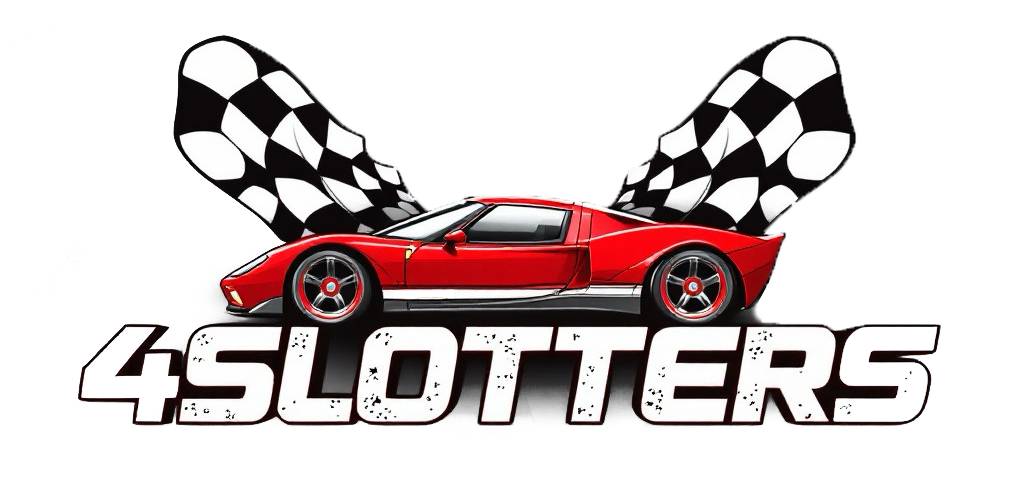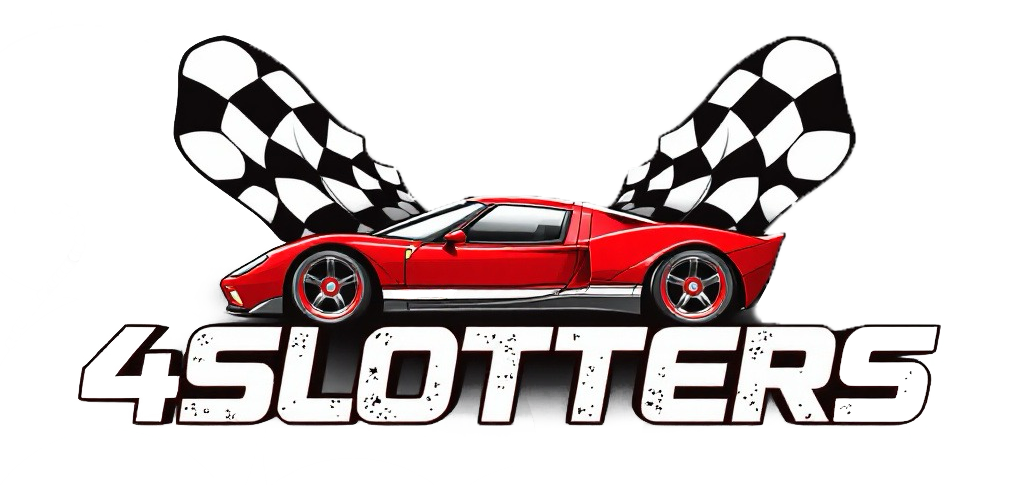Even with regular maintenance, slot car enthusiasts occasionally encounter performance issues. This comprehensive troubleshooting guide will help you identify and resolve common problems, getting your cars back on track quickly and efficiently. Whether you're dealing with cars that won't run, inconsistent performance, or track issues, we've got you covered with expert solutions.
Symptoms: Car sits motionless on track despite controller input
Possible Causes and Solutions:
-
No power to track
- Check power supply connection to wall outlet
- Verify power supply connection to track
- Test outlet with another device
- Check for tripped circuit breakers
-
Controller issues
- Inspect controller wire for damage
- Clean controller contacts with isopropyl alcohol
- Test with another controller if available
- Check controller connection to track
-
Car electrical problems
- Examine pickup shoes/braids for proper contact with track
- Clean pickup shoes/braids with isopropyl alcohol
- Check for broken wires between pickups and motor
- Test motor by applying power directly (for advanced users)
-
Track connection problems
- Ensure track sections are properly connected
- Clean track rails with track cleaning eraser
- Check for oxidation on track rails
- Verify all track power connections
Quick Fix: Try the car in a different lane or section of track to isolate whether the issue is with the car or the track.
Symptoms: Car starts and stops unpredictably during operation
Possible Causes and Solutions:
-
Dirty track rails
- Clean entire track with track cleaning eraser
- Wipe rails with isopropyl alcohol on a cloth
- Check for debris in track slots
-
Poor pickup contact
- Adjust pickup shoe spring tension if applicable
- Clean pickup shoes/braids thoroughly
- Replace worn pickup shoes/braids
- Ensure proper alignment of pickup assembly
-
Loose connections
- Check all wire connections inside the car
- Inspect solder joints if present
- Verify motor connections
- Tighten any loose screws
-
Track joint issues
- Clean track section connections
- Ensure track sections are firmly connected
- Look for misaligned track sections
- Check for damaged connector tabs
Quick Fix: A thorough cleaning of both the track rails and car pickup shoes often resolves intermittent running issues.
Symptoms: Car lacks expected speed and acceleration
Possible Causes and Solutions:
-
Insufficient power
- Check power supply output (voltage)
- Verify power supply capacity for your layout
- Test with a different power supply if available
- Consider a higher-capacity power supply for larger layouts
-
Mechanical resistance
- Check for binding in wheels or axles
- Look for hair or debris wrapped around axles
- Verify proper gear mesh
- Ensure body isn't rubbing against wheels
-
Motor issues
- Clean motor with compressed air
- Apply proper lubricant to motor bushings
- Check for worn motor brushes
- Test motor voltage and current draw (advanced)
-
Controller problems
- Verify controller is functioning properly
- Clean controller resistor track if accessible
- Check for controller overheating
- Test with another controller
Quick Fix: Proper lubrication of all moving parts often improves speed issues.
Symptoms: Car jumps out of slot during normal operation
Possible Causes and Solutions:
-
Guide flag/pin problems
- Check guide for damage or excessive wear
- Verify guide moves freely in its housing
- Ensure proper guide depth in slot
- Replace damaged guide flag/pin
-
Track issues
- Look for misaligned track sections
- Check for damaged slot edges
- Verify consistent slot width throughout track
- Repair or replace damaged track sections
-
Speed-related derailing
- Reduce power on problematic sections
- Add guardrails to challenging corners
- Adjust driving technique for problem areas
- Consider adding magnets for additional downforce
-
Car balance problems
- Check for proper weight distribution
- Verify body is securely mounted
- Ensure chassis is not twisted
- Add weight to stabilize if necessary
Quick Fix: Adding small strips of tape as guardrails at problem corners can provide a temporary solution.
Symptoms: Motor runs and wheels turn, but car makes little or no forward progress
Possible Causes and Solutions:
-
Tire grip issues
- Clean tires with isopropyl alcohol
- Check for hardened or glazed tires
- Apply tire conditioner for rubber/silicone tires
- Replace worn tires
-
Gear problems
- Inspect for stripped gear teeth
- Check for proper gear mesh
- Look for debris in gear train
- Replace damaged gears
-
Axle issues
- Verify axle is properly connected to gear
- Check for slipping set screws
- Ensure axle is not bent
- Look for proper wheel hub engagement
-
Clutch problems (if equipped)
- Adjust clutch tension
- Clean clutch components
- Check for worn clutch parts
- Replace clutch assembly if necessary
Quick Fix: For immediate traction improvement, lightly sand rubber tires with very fine sandpaper or clean thoroughly with alcohol.
Symptoms: Car produces unusual grinding, whining, or clicking sounds
Possible Causes and Solutions:
-
Gear mesh issues
- Adjust motor position for proper gear mesh
- Check for damaged gear teeth
- Verify proper lubrication
- Replace worn gears
-
Bearing/bushing problems
- Lubricate axle bushings
- Check for worn or damaged bearings
- Verify axles spin freely
- Replace worn bushings or bearings
-
Motor noise
- Inspect motor for foreign objects
- Check for worn motor brushes
- Verify proper motor mounting
- Consider motor replacement if bearings are worn
-
Body resonance
- Ensure body is properly secured
- Add small foam pads between body and chassis
- Check for body rubbing on moving parts
- Verify all mounting screws are tight
Quick Fix: Proper lubrication of gears and moving parts often reduces noise significantly.
Symptoms: Cars consistently lose power at specific track locations
Possible Causes and Solutions:
-
Poor track connections
- Clean connection tabs between track sections
- Ensure track sections are firmly connected
- Check for damaged connector tabs
- Add additional power taps for larger layouts
-
Rail damage
- Inspect rails for physical damage
- Look for excessive wear or oxidation
- Clean rails thoroughly
- Repair or replace damaged track sections
-
Power distribution issues
- Add power taps to sections far from power supply
- Use heavier gauge wire for power connections
- Consider multiple power supplies for large layouts
- Check for voltage drop across layout (advanced)
-
Controller problems
- Test with different controller
- Check controller wiring
- Verify controller base connections
- Clean controller contacts
Quick Fix: Adding a power tap near problem areas often resolves dead spots on larger layouts. Explore our track parts for power connection solutions.
Symptoms: Erratic car behavior related to controller input
Possible Causes and Solutions:
-
Dirty contacts
- Clean all controller contacts
- Check for corrosion on connector pins
- Verify smooth operation of trigger/throttle
- Inspect internal components if accessible
-
Wiring problems
- Look for damaged controller wire
- Check for intermittent connections
- Verify proper wiring at track connection
- Repair or replace damaged wires
-
Resistor issues
- Test controller resistance (advanced)
- Check for overheating
- Look for worn resistor track in electronic controllers
- Consider controller rebuild or replacement
-
Electronic controller problems
- Check battery if battery-powered
- Verify proper programming if programmable
- Reset to factory defaults if possible
- Update firmware if applicable
Quick Fix: Often, simply unplugging and reconnecting the controller while ensuring clean contacts resolves minor issues.
Symptoms: Power supply shuts down or circuit breaker trips when system is powered on
Possible Causes and Solutions:
-
Track problems
- Look for metal debris across rails
- Check for damaged track insulation between rails
- Inspect for wire insulation damage
- Test track sections individually to isolate problem
-
Car issues
- Verify pickup shoes/braids aren't touching both rails simultaneously
- Check for internal short circuits in cars
- Inspect motor for shorts
- Test without cars on track
-
Wiring issues
- Look for damaged wire insulation
- Check for incorrect wiring connections
- Verify proper polarity throughout system
- Inspect for pinched wires
-
Power supply problems
- Test power supply without track connected
- Verify power supply is appropriate for your system
- Check for power supply damage
- Consider power supply replacement if faulty
Quick Fix: Remove all cars from the track and test each one individually to identify if a particular car is causing the short circuit.
Symptoms: Digital car fails to respond to lane change commands
Possible Causes and Solutions:
-
Chip programming issues
- Reprogram car digital chip
- Reset chip to factory defaults
- Verify proper car addressing
- Update chip firmware if applicable
-
Lane change mechanism problems
- Check for physical damage to lane changers
- Verify proper power to lane change sections
- Clean lane change contacts
- Test with another car to isolate the issue
-
Controller issues
- Verify lane change button functionality
- Check controller programming
- Ensure proper controller connection
- Test with another controller
-
Track problems
- Inspect lane change track sections
- Clean lane change contacts
- Check for proper power to lane changers
- Verify correct track wiring
Quick Fix: Reprogramming the car's digital chip often resolves lane changing issues. Not sure about digital systems? Read our Digital vs. Analog Systems guide.
Symptoms: Digital car moves without controller input or responds to wrong controller
Possible Causes and Solutions:
-
Address conflicts
- Reprogram car with unique address
- Verify no duplicate car addresses on track
- Reset control unit
- Check for interference from other digital devices
-
Control unit issues
- Restart control unit
- Update control unit firmware
- Reset to factory defaults
- Check for overheating
-
Signal interference
- Move potential interference sources away from track
- Check for proper system grounding
- Verify correct wiring installation
- Shield sensitive components if necessary
-
Controller problems
- Test with different controller
- Check for controller button stuck in pressed position
- Verify controller is properly paired with car
- Reset controller if possible
Quick Fix: Removing all cars from the track, powering down the system completely, then restarting often resolves digital system glitches.
The best troubleshooting is prevention:
-
Regular maintenance
- Clean track and cars after each use
- Perform regular lubrication as outlined in our Maintenance Guide
- Inspect for wear before problems occur
- Keep electrical contacts clean
-
Proper storage
- Store cars in protective cases
- Keep track clean and covered when not in use
- Maintain moderate humidity and temperature
- Avoid direct sunlight on track and cars
-
Quality components
- Invest in quality power supplies
- Use recommended lubricants and cleaners
- Purchase replacement parts from reputable sources
- Consider quality over price for critical components
Troubleshooting slot car issues requires patience and a methodical approach. Remember:
- Address one issue at a time
- Make only one change before testing again
- Document what works and what doesn't
- Learn from each troubleshooting experience
With this guide and a systematic approach, you'll be able to resolve most common slot car problems and get back to enjoying this fantastic hobby.








